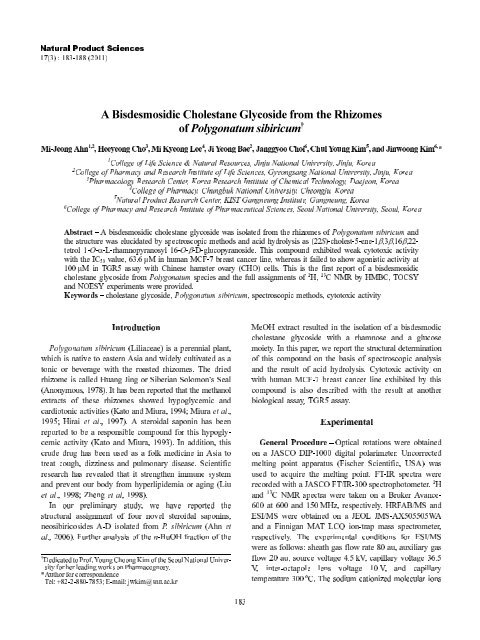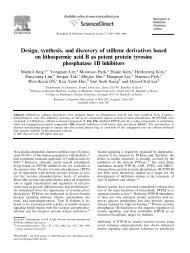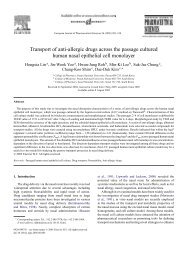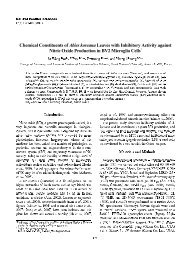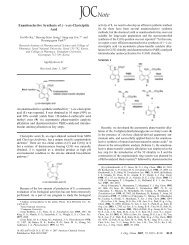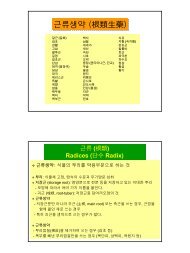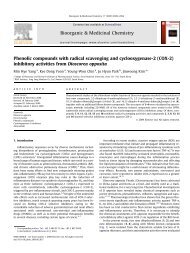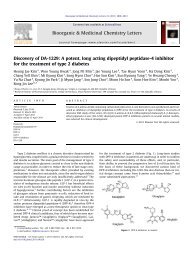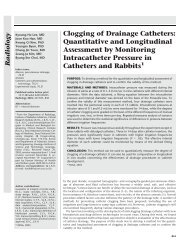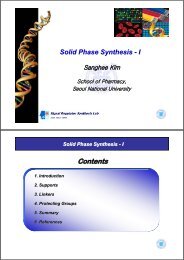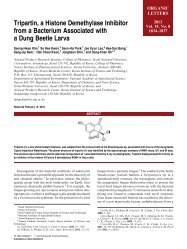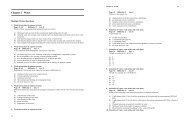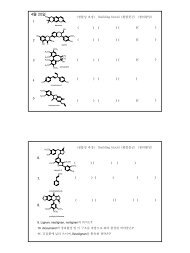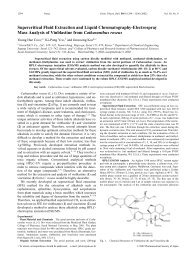A Bisdesmosidic Cholestane Glycoside from the Rhizomes of ...
A Bisdesmosidic Cholestane Glycoside from the Rhizomes of ...
A Bisdesmosidic Cholestane Glycoside from the Rhizomes of ...
You also want an ePaper? Increase the reach of your titles
YUMPU automatically turns print PDFs into web optimized ePapers that Google loves.
Product Sciences<br />
Natural<br />
: 183-188 (2011)<br />
17(3)<br />
1<br />
<strong>of</strong> Life Science & Natural Resources, Jinju National University, Jinju, Korea<br />
College<br />
2<br />
<strong>of</strong> Pharmacy and Research Institute <strong>of</strong> Life Sciences, Gyeongsang National University, Jinju, Korea<br />
College<br />
3<br />
Research Center, Korea Research Institute <strong>of</strong> Chemical Technology, Daejeon, Korea<br />
Pharmacology<br />
4<br />
<strong>of</strong> Pharmacy, Chungbuk National University, Cheongju, Korea<br />
College<br />
5<br />
Product Research Center, KIST Gangneung Institute, Gangneung, Korea<br />
Natural<br />
6<br />
<strong>of</strong> Pharmacy and Research Institute <strong>of</strong> Pharmaceutical Sciences, Seoul National University, Seoul, Korea<br />
College<br />
− A bisdesmosidic cholestane glycoside was isolated <strong>from</strong> <strong>the</strong> rhizomes <strong>of</strong> Polygonatum sibiricum and<br />
Abstract<br />
structure was elucidated by spectroscopic methods and acid hydrolysis as (22S)-cholest-5-ene-1β,3β,16β,22-<br />
<strong>the</strong><br />
1-O-α-L-rhamnopyranosyl 16-O-β-D-glucopyranoside. This compound exhibited weak cytotoxic activity<br />
tetrol<br />
<strong>the</strong> IC 50 value, 63.6 µM in human MCF-7 breast cancer line, whereas it failed to show agonistic activity at<br />
with<br />
µM in TGR5 assay with Chinese hamster ovary (CHO) cells. This is <strong>the</strong> first report <strong>of</strong> a bisdesmosidic<br />
100<br />
glycoside <strong>from</strong> Polygonatum species and <strong>the</strong> full assignments <strong>of</strong> 1 H, 13 C NMR by HMBC, TOCSY<br />
cholestane<br />
NOESY experiments were provided.<br />
and<br />
− cholestane glycoside, Polygonatum sibiricum, spectroscopic methods, cytotoxic activity<br />
Keywords<br />
sibiricum (Liliaceae) is a perennial plant,<br />
Polygonatum<br />
is native to eastern Asia and widely cultivated as a<br />
which<br />
or beverage with <strong>the</strong> roasted rhizomes. The dried<br />
tonic<br />
is called Huang Jing or Siberian Solomon’s Seal<br />
rhizome<br />
1978). It has been reported that <strong>the</strong> methanol<br />
(Anonymous,<br />
<strong>of</strong> <strong>the</strong>se rhizomes showed hypoglycemic and<br />
extracts<br />
activities (Kato and Miura, 1994; Miura et al.,<br />
cardiotonic<br />
Hirai et al., 1997). A steroidal saponin has been<br />
1995;<br />
to be a responsible compound for this hypoglycemic<br />
reported<br />
activity (Kato and Miura, 1993). In addition, this<br />
drug has been used as a folk medicine in Asia to<br />
crude<br />
cough, dizziness and pulmonary disease. Scientific<br />
treat<br />
has revealed that it streng<strong>the</strong>n immune system<br />
research<br />
prevent our body <strong>from</strong> hyperlipidemia or aging (Liu<br />
and<br />
al., 1998; Zheng et al, 1998).<br />
et<br />
our preliminary study, we have reported <strong>the</strong><br />
In<br />
assignment <strong>of</strong> four novel steroidal saponins,<br />
structural<br />
A-D isolated <strong>from</strong> P. sibiricum (Ahn et<br />
neosibiricosides<br />
Dedicated to Pr<strong>of</strong>. Young Choong Kim <strong>of</strong> <strong>the</strong> Seoul National University<br />
† for her leading works on Pharmacognosy.<br />
for correspondence<br />
*Author<br />
+82-2-880-7853; E-mail: jwkim@snu.ac.kr<br />
Tel:<br />
extract resulted in <strong>the</strong> isolation <strong>of</strong> a bisdesmodic<br />
MeOH<br />
glycoside with a rhamnose and a glucose<br />
cholestane<br />
In this paper, we report <strong>the</strong> structural determination<br />
moiety.<br />
this compound on <strong>the</strong> basis <strong>of</strong> spectroscopic analysis<br />
<strong>of</strong><br />
<strong>the</strong> result <strong>of</strong> acid hydrolysis. Cytotoxic activity on<br />
and<br />
human MCF-7 breast cancer line exhibited by this<br />
with<br />
is also described with <strong>the</strong> result at ano<strong>the</strong>r<br />
compound<br />
assay, TGR5 assay.<br />
biological<br />
Procedure − Optical rotations were obtained<br />
General<br />
a JASCO DIP-1000 digital polarimeter. Uncorrected<br />
on<br />
point apparatus (Fischer Scientific, USA) was<br />
melting<br />
to acquire <strong>the</strong> melting point. FT-IR spectra were<br />
used<br />
with a JASCO FT/IR-300 spectrophotometer. 1 H<br />
recorded 13<br />
C NMR spectra were taken on a Bruker Avance-<br />
and<br />
at 600 and 150 MHz, respectively. HRFAB/MS and<br />
600<br />
were obtained on a JEOL JMS-AX505505WA<br />
ESI/MS<br />
a Finnigan MAT LCQ ion-trap mass spectrometer,<br />
and<br />
The experimental conditions for ESI/MS<br />
respectively.<br />
as follows: sheath gas flow rate 80 au, auxiliary gas<br />
were<br />
20 au, source voltage 4.5 kV, capillary voltage 36.5<br />
flow<br />
inter-octapole lens voltage 10 V, and capillary<br />
V,<br />
300 o C. The sodium cationized molecular ions<br />
temperature<br />
A <strong>Bisdesmosidic</strong> <strong>Cholestane</strong> <strong>Glycoside</strong> <strong>from</strong> <strong>the</strong> <strong>Rhizomes</strong><br />
<strong>of</strong> Polygonatum sibiricum †<br />
Mi-Jeong Ahn 1,2 , Heeyeong Cho 3 , Mi Kyeong Lee 4 , Ji Yeong Bae 2 , Janggyoo Choi 6 , Chul Young Kim 5 , and Jinwoong Kim 6, *<br />
Introduction<br />
Experimental<br />
al., 2006). Fur<strong>the</strong>r analysis <strong>of</strong> <strong>the</strong> n-BuOH fraction <strong>of</strong> <strong>the</strong><br />
183
isolated with an isolation width <strong>of</strong> 2 m/z units and<br />
were<br />
using a collision energy <strong>of</strong> 55% for MS 2<br />
fragmented<br />
GC was conducted on a GC353B-FSL gas<br />
experiments.<br />
(GL Sciences) with a flame ionization<br />
chromatograph<br />
(FID). TLC was carried out on silica gel precoated<br />
detector<br />
(Art. No. 5715, Merck). Silica gel 60 (40 - 63 µm,<br />
plates<br />
9385, Merck) and ODS-A YMC Gel (12 nm -<br />
Art.<br />
µm, AA12SA5, Kyoto, Japan) were used for column<br />
150<br />
All chemicals used in bioassay were <strong>of</strong><br />
chromatography.<br />
reagent grade.<br />
biochemical<br />
Material − The rhizomes <strong>of</strong> Polygonatum<br />
Plant<br />
Redouté (Liliaceae) were collected in Kyeongki<br />
sibiricum<br />
<strong>of</strong> Korea in April, 2005. This plant was<br />
province<br />
by Pr<strong>of</strong>. Jong Hee Park <strong>of</strong> <strong>the</strong> College <strong>of</strong><br />
identified<br />
Pusan National University, Korea. A voucher<br />
Pharmacy,<br />
(SNUPH-0328) is deposited in <strong>the</strong> Herbarium<br />
specimen<br />
<strong>the</strong> College <strong>of</strong> Pharmacy, Seoul National University.<br />
<strong>of</strong><br />
and Isolation − The fresh rhizomes (30 kg)<br />
Extraction<br />
P. sibiricum were extracted twice with 100% MeOH<br />
<strong>of</strong><br />
L) and evaporated in vacuo. The MeOH extract (3.8<br />
(30<br />
was dissolved in water and partitioned with n-butanol.<br />
kg)<br />
n-butanol layer (75 g) was concentrated in vacuo and<br />
The<br />
into five fractions (F.1 - F.5) on silica gel column<br />
divided<br />
(Merck, 230 - 400 mesh, 1 kg) using<br />
chromatography<br />
3 -MeOH-H 2 O mixtures <strong>of</strong> increasing polarity (30 :<br />
CHCl<br />
: 1 (F.1), 15 : 5 : 1 (F.2), 10 : 5 : 1 (F.3, F.4), 6 : 5 : 1<br />
5<br />
3 L <strong>of</strong> each). The F.4 fraction (12 g) was <strong>the</strong>n<br />
(F.5),<br />
on ODS silica gel to give five<br />
chromatographed<br />
Compound 1 (11 mg) was purified <strong>from</strong><br />
subfractions.<br />
2 by Sep-Pack cartilage (Waters C 18 , USA)<br />
subfraction<br />
crystallization in aqueous MeOH solution.<br />
and<br />
<strong>of</strong> Sugar Components <strong>of</strong> Compound 1 −<br />
Analysis<br />
acidic hydrolysis <strong>of</strong> compound 1 (1 mg) and <strong>the</strong><br />
The<br />
L-cysteine derivatization <strong>of</strong> <strong>the</strong> mono-<br />
trimethylsilyl<br />
were carried out according to <strong>the</strong> previous<br />
saccharide<br />
paper (Ahn et al., 2006). Under <strong>the</strong>se conditions,<br />
published<br />
sugars gave peaks at t R (min); 11.38 and 12.23<br />
standard<br />
D- and L-glucose, and 8.42 for L-rhamnose, respectively.<br />
for<br />
1 − amorphous powder; [α] 20 D −45.8 o (c<br />
Compound<br />
MeOH); IR (KBr) ν max 3430 (OH), 2926 (CH),<br />
0.13,<br />
1371, 1265, 1067, 824 cm −1 ; 1 H NMR and 13 C<br />
1453,<br />
see Table 1; ESIMS (positive mode) m/z 765 [M +<br />
NMR,<br />
+<br />
; HRFABMS m/z 765.4421 (calcd for C 39 H 66 O 13 Na,<br />
Na]<br />
mp: 177 - 179 o C<br />
765.4401);<br />
assay − Cytotoxic activity was evaluated<br />
Cytotoxicity<br />
MCF-7 cells according to <strong>the</strong> previous published<br />
with<br />
(Ahn et al., 2006).<br />
paper<br />
assay − Chinese hamster ovary (CHO) cells<br />
TGR5<br />
transfected with CREB-luc were obtained <strong>from</strong><br />
stably<br />
and were maintained in F12K supplemented<br />
Panomics,<br />
1. 1 H and 13 C NMR Spectral Data for Compound 1 (in<br />
Table<br />
5 D 5 N) a<br />
C<br />
4.37 dd (11.8, 4.5)<br />
6''b<br />
a<br />
for positions 26 and 27 are exchangeable each o<strong>the</strong>r.<br />
Signals<br />
10% fetal bovine serum, 100 U/mL penicillin, 100<br />
with<br />
streptomycin sulfate, and hygromycin (100 µg/<br />
µg/mL<br />
For <strong>the</strong> TGR5 assay, a stable cell line was obtained<br />
ml).<br />
transfection with TGR5 expression plasmid (pCMV6/<br />
by<br />
184 Natural Product Sciences<br />
position δ H δ C HMBC<br />
1 3.72 dd (11.5, 3.6) 81.1 H-1'<br />
2 2.78 br d, 2.47 35.7<br />
3 3.81 m 67.8 H-4<br />
4 2.64, 2.52 43.4 H-6<br />
5 138.8<br />
6 5.46 m 124.9<br />
7 1.73, 1.35 31.2 H-6<br />
8 1.25 33.2 H-6, H-15<br />
9 1.24 50.5 H-1, H-19<br />
10 42.6 H-1, H-6, H-9, H-11, H-19<br />
11 2.58, 1.55 24.6<br />
12 2.05, 1.45 40.3 H-17, H-18<br />
13 42.0<br />
14 0.84 55.0<br />
15 2.28, 1.74 36.9<br />
16 4.50 82.3 H-1''<br />
17 1.96 dd (10.8, 7.6) 57.8 H-14, H-15, H-18, H-21<br />
18 0.97 s 13.6 H-12, H-17<br />
19 1.14 s 14.3 H-1<br />
20 1.85 35.6 H-17, H-21<br />
21 1.12 d (7.2) 12.3<br />
22 4.29 72.8<br />
23 1.83, 1.77 33.7<br />
24 1.89, 1.59 36.4 H-25, H-26, H-27<br />
25 1.58 28.7 H-24, H-26, H-27<br />
26 0.85 22.8 H-25<br />
27 0.86 22.9 H-25<br />
1' 5.60 (br s) 97.5 H-1<br />
2' 4.49 dd (br d) 72.7 H-1'<br />
3' 4.44 dd (7.6) 72.6 H-1'<br />
4' 4.25 dd 73.3<br />
5' 4.22 m 70.4 H-1', H-4', H-6'<br />
6' 1.60 d (6.1) 18.5 H-5'<br />
1'' 4.71 d (7.2) 106.7<br />
2'' 3.97 dd (7.7, 7.2) 75.3 H-1''<br />
3'' 4.13 dd (7.7, 7.5) 78.5 H-1''<br />
4'' 4.23 dd (7.5, 7.3) 71.3<br />
5'' 3.80 m 77.9 H-1''<br />
6''a 4.47 br d 62.5 H-4'', H-5''
Fig. 1. Chemical structure <strong>of</strong> compound 1.<br />
Origene) using Lip<strong>of</strong>ectamine 2000 reagent<br />
TGR5,<br />
The transfected cells were selected with 600<br />
(Invitrogen).<br />
G418 sulfate, and single clones were grown in a<br />
µg/mL<br />
plate, independently. Samples were tested by<br />
96-well<br />
on <strong>the</strong> selected CHO/CREB-luc/TGR5 cell<br />
luminescence<br />
The biological effects <strong>of</strong> samples on TGR5 were<br />
line.<br />
to those <strong>of</strong> lithocholic acid (Sigma, USA) used<br />
compared<br />
an internal control in <strong>the</strong> luciferase assay. TGR5-<br />
as<br />
CHO cells were treated for 5 h with 10 µM<br />
expressing<br />
acid or 100 µM sample, followed by a<br />
lithocholic<br />
assay. Luminescence was determined with<br />
luciferase<br />
alpha (PerkinElmer).<br />
Fusion<br />
concentrated MeOH extract <strong>of</strong> <strong>the</strong> rhizomes <strong>of</strong> P.<br />
The<br />
was partitioned between n-BuOH and water.<br />
sibiricum<br />
n-BuOH-soluble fraction was chromatographed on Si<br />
The<br />
octadecylsilanized (ODS) Si gel to give compound 1<br />
gel,<br />
1). (Fig.<br />
1, obtained as an amorphous powder,<br />
Compound<br />
a positive dark-green color by Lieberman-Burchard<br />
showed<br />
on TLC plate. In <strong>the</strong> positive-ion ESIMS <strong>of</strong> 1, a<br />
reagent<br />
quasimolecular ion peak at m/z 765 [M + Na] +<br />
and HRFABMS analysis revealed <strong>the</strong> molecular<br />
observed,<br />
to be C 39 H 66 O 13 .<br />
formula<br />
1 H-NMR spectrum <strong>of</strong> 1 showed signals for two<br />
The<br />
methyl groups at δ 0.97 and 1.14 (each 3H, s),<br />
tertiary<br />
at δ 1.60 (d, J = 6.1 Hz) was due to <strong>the</strong> methyl<br />
signal<br />
<strong>of</strong> 6-deoxyhexopyranose. Two anomeric proton<br />
group<br />
were also found at δ 5.60 (br s) and 4.71 (d,<br />
signals<br />
= 7.2 Hz). From <strong>the</strong> 13 C NMR spectrum showing 39<br />
J<br />
lines, 27 <strong>of</strong> <strong>the</strong>m were attributed to aglycone part<br />
resonance<br />
12 to two monosaccharides. These NMR data supported<br />
and<br />
fact that 1 has a steroidal skeleton and two saccharide<br />
<strong>the</strong><br />
All <strong>the</strong> carbon signals <strong>of</strong> its aglycone were<br />
moieties.<br />
with those <strong>of</strong> previously reported (22S)-cholest-5-<br />
consistent<br />
moiety (Mimaki et al., 1999).<br />
ene-1β,3β,16β,22-tetrol<br />
2. GC chromatogram <strong>of</strong> acid hydrolysate (trimethylsilyl L-<br />
Fig.<br />
derivatives) <strong>of</strong> compound 1. Two major peaks indicate<br />
cysteine<br />
monosaccharides obtained <strong>from</strong> <strong>the</strong> acidic hydrolysis<br />
The<br />
1 were identified as D-glucose and L-rhamnose with<br />
<strong>of</strong><br />
molar ratio <strong>of</strong> 1 : 1 by GC <strong>of</strong> <strong>the</strong>ir respective<br />
<strong>the</strong><br />
L-cysteine derivatives (Fig. 4) (Agrawal et<br />
trimethylsilyl<br />
1985; Hara et al., 1987). The β-orientations <strong>of</strong> <strong>the</strong><br />
al.,<br />
moiety was supported by <strong>the</strong> relatively large J<br />
glucose<br />
<strong>of</strong> <strong>the</strong> anomeric proton (J = 7.2 Hz for H-1'') and<br />
values<br />
chemical shift (δ 106.7) <strong>of</strong> <strong>the</strong> anomeric carbon. The<br />
<strong>the</strong><br />
<strong>of</strong> <strong>the</strong> L-rhamnose was confirmed by<br />
α-configuration 13<br />
C shifts because remarkable differences in <strong>the</strong> 13 C<br />
<strong>the</strong>ir<br />
at C-3 and C-5 were recognized between α-, and β-<br />
shifts<br />
(Agrawal et al., 1985; Agrawal et<br />
L-rhamnopyranosides<br />
1992). al.,<br />
monosaccharide was considered to be directly<br />
Each<br />
to <strong>the</strong> aglycone and was not substituted because<br />
attached<br />
glycosylation shifts could be observed among <strong>the</strong><br />
no<br />
13 C NMR shifts (Mimaki et al., 2000). This fact<br />
assigned<br />
revealed by <strong>the</strong> following correlations in <strong>the</strong> HMBC<br />
was<br />
(Fig. 3). The H-1 proton (δ 3.72) <strong>of</strong> <strong>the</strong><br />
spectrum<br />
and <strong>the</strong> anomeric proton (δ 4.71) <strong>of</strong> glucose<br />
aglycone<br />
correlations with <strong>the</strong> anomeric carbon <strong>of</strong><br />
showed<br />
(δ 97.5) and <strong>the</strong> C-16 carbon (δ 82.3) <strong>of</strong> <strong>the</strong><br />
rhamnose<br />
respectively. These correlations were also<br />
aglycone,<br />
by NOESY spectrum and anomeric carbon<br />
confirmed<br />
(δ 97.5 and 106.7 for rhamnose and glucose,<br />
signals<br />
different <strong>from</strong> those (δ 104.9 and 101.3) <strong>of</strong><br />
respectively)<br />
1-O-β-D-gluco-<br />
16-O-α-L-rhamnopyranoside. 1D-selective TOCSY<br />
pyranosyl<br />
allowed <strong>the</strong> sequential assignments <strong>of</strong> all<br />
experiment<br />
for each monosaccharide, starting <strong>from</strong> <strong>the</strong><br />
resonances<br />
protons (Fig. 4).<br />
anomeric<br />
Vol. 17, No. 3, 2011 185<br />
L-rhamnose (A) and D-glucose (B), respectively.<br />
Fig. 3. HMBC correlations <strong>of</strong> compound 1.<br />
Results and Discussion<br />
was<br />
secondary methyl groups at δ 1.12 (d, J = 7.2 Hz), δ<br />
three<br />
and 0.86, and an olefinic proton at δ 5.46 (m). The<br />
0.85<br />
(22S)-cholest-5-ene-1β,3β,16β,22-tetrol
Fig. 4. 1 H-NMR spectrum (A) and δ 4.75 selective TOCSY spectrum (B) <strong>of</strong> compound 1 (600 MHz, in C 5 D 5 N).<br />
compound 1 displayed a quasimolecular<br />
Meanwhile,<br />
peak at m/z 765 [M + Na] + and m/z 781 [M + K] + .<br />
ion<br />
The MS/MS spectrum <strong>of</strong> <strong>the</strong> [M + Na] +<br />
<strong>of</strong> a hydroxy group (18 Da) in aglycone moiety, a<br />
loss<br />
unit (146 Da) and a glucose unit (162 Da),<br />
rhamnose<br />
In addition, it exhibited <strong>the</strong> peaks at m/z 403<br />
respectively.<br />
+ Na − Glc − Rhm − 3H 2 O] + due to <strong>the</strong> successive<br />
[M<br />
<strong>of</strong> two saccharide moieties and three hydroxy groups.<br />
loss<br />
peaks at m/z 695 [M + Na − C 5 H 10 ] +<br />
resulted <strong>from</strong><br />
The<br />
cleavage <strong>of</strong> side chain <strong>of</strong> <strong>the</strong> aglycone (Fig. 5).<br />
<strong>the</strong><br />
<strong>the</strong> basis <strong>of</strong> <strong>the</strong> obtained data, <strong>the</strong> structure <strong>of</strong><br />
On<br />
1 was assigned as (22S)-cholest-5-ene-<br />
compound<br />
1-O-α-L-rhamnopyranosyl 16-O-β-<br />
1β,3β,16β,22-tetrol<br />
(Mimaki et al., 1999). This compound<br />
D-glucopyranoside<br />
to rare cholestane bisdesmosides possessing<br />
belongs<br />
residues linked to a polyhydroxycholesterol<br />
disaccharide<br />
<strong>Bisdesmosidic</strong> cholestane glycosides have been<br />
aglycone.<br />
<strong>from</strong> several Liliaceae plants. Since compound 1<br />
isolated<br />
firstly isolated <strong>from</strong> a plant source, Allium jesdianum,<br />
was<br />
has been reported to be isolated <strong>from</strong> tubers or bulbs or<br />
it<br />
<strong>of</strong> Liliaceae plants (Dai et al., 2000; Fattorusso et al.,<br />
seed<br />
Sang et al., 2000; Higano et al., 2007). Partial<br />
2000;<br />
or overlapped signals in CD 3 OD has been<br />
assignment<br />
reported (Fattorusso et al., 2000). However,<br />
previously<br />
is <strong>the</strong> first report <strong>of</strong> a bisdesmodic cholestane<br />
this<br />
<strong>from</strong> <strong>the</strong> genus Polygonatum. In this study, <strong>the</strong><br />
glycoside<br />
assignment <strong>of</strong> 1 H-NMR spectrum by HSQC, TOCSY<br />
full<br />
NOESY experiments was also provided.<br />
and<br />
compound 1 was reported not to have shown<br />
Although<br />
activity against HL-60 cells, this compound<br />
cytotoxic<br />
weak cytotoxic activity with <strong>the</strong> IC 50 value, 63.6<br />
exhibited<br />
in human MCF-7 breast cancer line (Mimaki et al.,<br />
µM<br />
Meanwhile, TGR5 is an emerging bile acid G-<br />
1999).<br />
receptor target for <strong>the</strong> potential treatment<br />
protein-coupled<br />
metabolic disorders or inflammation (Atul and Pranab,<br />
<strong>of</strong><br />
186 Natural Product Sciences<br />
ion showed <strong>the</strong><br />
at m/z 747 [M + Na − H 2 O] + , 601 [M + Na − Rhm −<br />
peaks<br />
2 O] + and 585 [M + Na − Glc − H 2 O] + resulting <strong>from</strong><br />
H<br />
2009; Thijs et al., 2011). For example, TGR5 activation
Fig. 5. ESI MS spectrum <strong>of</strong> <strong>the</strong> sodium cationized compound 1 (A) and MS/MS spectrum <strong>of</strong> <strong>the</strong> molecular ion at m/z 765 (B-D).<br />
a significant reduction <strong>of</strong> <strong>the</strong> body weight <strong>of</strong> mice<br />
induces<br />
a high fat diet (Watanabe, 2006). Since compound 1<br />
fed<br />
<strong>the</strong> same cholestane structure with bile acids, ligands<br />
has<br />
this receptor, TGR5 assay was accomplished with this<br />
for<br />
using Chinese hamster ovary (CHO) cells and a<br />
isolate<br />
acid, lithocholic acid as a positive control. However,<br />
bile<br />
compound failed to show agonistic activity on TGR5<br />
this<br />
It was suggested that it could have resulted <strong>from</strong><br />
receptor.<br />
<strong>of</strong> negatively charged functional groups or presence<br />
lack<br />
a double bond to increase molecular rigidity or bulky<br />
<strong>of</strong><br />
moieties <strong>of</strong> this bisdesmosidic cholestane<br />
saccharide<br />
(Atul and Pranab, 2009).<br />
glycoside<br />
work was supported by 2010 Jinju National<br />
This<br />
Industry Academic Cooperation Foundation<br />
University<br />
Dictionary <strong>of</strong> Chinese Medicinal Materials, Shanghai<br />
Anonymous,<br />
and Technological Press, Shanghai, Vol. 2, pp. 2041-2044,<br />
Scientific<br />
1978.<br />
P.K., Jain, D.C., Gupta, R.K., and Thakur, R.S., Carbon-13<br />
Agrawal,<br />
spectroscopy <strong>of</strong> steroidal sapogenins and steroidal saponins.<br />
NMR<br />
24, 2479-2496 (1985).<br />
Phytochemistry<br />
P.K., NMR Spectroscopy in <strong>the</strong> structural elucidation <strong>of</strong><br />
Agrawal,<br />
and glycosides. Phytochemistry 31, 3307-3330<br />
oligosaccharides<br />
(1992).<br />
M.-J., Kim, C.Y., Yoon, K.D., Ryu, M.Y., Cheong, J.H., Chin, Y.W.,<br />
Ahn,<br />
Kim, J., Steroidal Saponins <strong>from</strong> <strong>the</strong> <strong>Rhizomes</strong> <strong>of</strong> Polygonatum<br />
and<br />
J. Nat. Prod. 69, 360-364 (2006).<br />
sibiricum.<br />
Tiwari. and Pranab, Maiti., TGR5: an emerging bile acid G-proteincoupled<br />
Atul,<br />
receptor target for <strong>the</strong> potential treatment <strong>of</strong> metabolic<br />
Drug Discov. Today 14, 523-530 (2009).<br />
disorders.<br />
H., Zhou, J., Deng, S., and Tan, N., <strong>Glycoside</strong>s <strong>from</strong> Ophiopogon<br />
Dai,<br />
Tianran Chanwu Yanjiu Yu Kaifa 12, 5-7 (2000).<br />
japonicas.<br />
E., Lanzotti, V., Taglialatela-Scafati, O., Rosa, M.D., and<br />
Fattorusso,<br />
A., Cytotoxic saponins <strong>from</strong> bulbs <strong>of</strong> Allium porrum L. J.<br />
Ianaro,<br />
Food Chem. 48, 3455-3462 (2000).<br />
Agric.<br />
Vol. 17, No. 3, 2011 187<br />
References<br />
Acknowledgment<br />
Grant.<br />
Hara, S., Okabe, H., and Mihashi, K., Gas-Liquid Chromatographic
<strong>of</strong> Aldose Enantiomers as Trimethylsilyl E<strong>the</strong>rs <strong>of</strong> Methyl<br />
Separation<br />
Chem. Pharm.<br />
2-(Polyhydroxyalkyl)-thiazolidine-4(R)-carboxylates.<br />
35, 501-507 (1987).<br />
Bull.<br />
T., Kuroda, M., Sakagami, H., and Mimaki, Y., Convallasaponin<br />
Higano,<br />
a new 5-spirostanol triglycoside <strong>from</strong> <strong>the</strong> rhizomes <strong>of</strong> Convallaria<br />
A,<br />
Chem. Pharm. Bull. 55, 337-339 (2007).<br />
majalis.<br />
N., Miura, T., Moriyasu, M., Ichimaru, M., Nishiyama, Y., Ogura,<br />
Hirai,<br />
and Kato, A., Cardiotonic activity <strong>of</strong> <strong>the</strong> rhizome <strong>of</strong> Polygonatum<br />
K.,<br />
in rats. Biol. Pharm. Bull. 20, 1271-1273 (1997).<br />
sibiricum<br />
A. and Miura, T., Hypoglycemic action <strong>of</strong> <strong>the</strong> rhizomes <strong>of</strong><br />
Kato,<br />
<strong>of</strong>ficinale in normal and diabetic mice. Planta Med., 60,<br />
Polygonatum<br />
(1994).<br />
201-203<br />
A. and Miura, T., Hypoglycemic activity <strong>of</strong> Polygonati rhizome in<br />
Kato,<br />
and diabetic mice. Biol. Pharm. Bull. 16, 1118-1120 (1993).<br />
normal<br />
Y.P., Fu, G.F., and Cui, H., Current advances on pharmacological<br />
Liu,<br />
<strong>of</strong> Huang Jing, Yu Zhu and <strong>the</strong>ir preparations. Li Shizhen<br />
researches<br />
and Materia Medica Research 4, 371-373 (1998).<br />
Medicine<br />
Y., Kuroda, M., Fukasawa, T., and Sashida, Y., Steroidal<br />
Mimaki,<br />
<strong>from</strong> <strong>the</strong> Bulbs <strong>of</strong> Allium jesdianum. J. Nat. Prod. 62, 194-<br />
<strong>Glycoside</strong>s<br />
(1999).<br />
197<br />
Y., Yokosuka, A., and Sashida, Y., Steroidal glycosides <strong>from</strong> <strong>the</strong><br />
Mimaki,<br />
parts <strong>of</strong> Polian<strong>the</strong>s tuberose. J. Nat. Prod. 63, 1519-1523<br />
aerial<br />
T., Kato, A., Usami, M., Kadowaki, S., and Seino, Y., Effect <strong>of</strong><br />
Miura,<br />
rhizome on blood glucose and facilitative glucose<br />
polygonati<br />
is<strong>of</strong>orm 2 (GLUT2) mRNA expression in Wistar fatty rats.<br />
transporter<br />
Pharm. Bull. 18, 624-625 (1995).<br />
Biol.<br />
T.W.H., Lilia, G.N., Nomura, M., Auwerxa, J., and Schoonjans, K.,<br />
Pols,<br />
bile acid membrane receptor TGR5 as an emerging target in<br />
The<br />
and inflammation. J. Hepatol. 54, 1263-1272 (2011).<br />
metabolism<br />
S., Xia, Z., Mao, S., Lao, A., and Chen, Z., Studies on chemical<br />
Sang,<br />
in seed <strong>of</strong> Allium tuberosum Rottl. Zhongguo Zhongyao<br />
constituents<br />
25, 286-288 (2000).<br />
Zazhi<br />
M., Houten, S.M., Mataki, C., Christ<strong>of</strong>folete, M.A., Kim,<br />
Watanabe,<br />
Sato, H., Messaddeq, N., Harney, J.W., Ezaki, O., Kodama, T.,<br />
B.W.,<br />
K., Bianco, A.C., and Auwerx, J., Bile acids induce<br />
Schoonjans,<br />
expenditure by promoting intracellular thyroid hormone<br />
energy<br />
Nature 439, 484-489 (2006).<br />
activation.<br />
H.Z., Dong, Z.H., and She, J., Modernization <strong>of</strong> Traditional<br />
Zheng,<br />
Medicine and Application, Xueyuan Press, Beijing, pp. 4071-<br />
Chinese<br />
1998.<br />
4074,<br />
July 20, 2011<br />
Received<br />
August 17, 2011<br />
Revised<br />
188 Natural Product Sciences<br />
Accepted August 20, 2011<br />
(2000).


